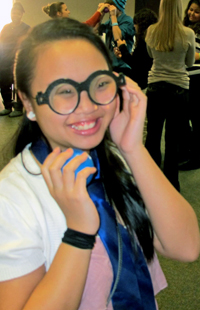“Oh my, this is weird!” An eighth grader from St. Matthew’s School tried to pick up an orange plastic ball from the floor and nearly fell over. She was wearing a pair of oversized glasses with thick misshapen lenses in them. The lenses magnified her eyes, making her look like some kind of insect. There was a big smile on her face.
UST psychology major Claire Maccani picked up the ball and asked her group of middle schoolers, “When you throw a ball, what do you need?” The group replied, “A sense of touch. The sense of sight.”
Last Tuesday, Early College Awareness (ECA) hosted a campus visit from St. Matthew’s, a Catholic school in West St. Paul with an ethnically and economically diverse student body. Housed in the CILCE office, the ECA program reaches out to students from populations traditionally underrepresented at college in order to teach them about higher education.
For this visit, 23 eighth-grade students from St. Matt’s came to UST to get a taste of what college life is like. They were lucky to hear from St. Matt’s alum David Hottinger, who was the first in his family to go to college and who now works at St. Thomas.

Students from St. Matt's participated in a psychology presentation led by Dr. Roxanne Prichard's class.
ECA student leaders Jess Urban and Bri Velzke and graduate assistant Caitlin Conley organized a day of activities for their visitors, starting with a game of Jeopardy.
“When a student lives at home and drives to school, they are called this.”
“What is a commuter?”
I was amazed – not that they knew the information, but because they were really getting into it. I was surprised. The kids from St. Matt’s had been on a whirlwind tour last week, visiting the state Capitol, eating at different restaurants, volunteering to clean a horse stable at 5:30 a.m., and watching two theater performances. They were clearly tired, but you could tell that they were having a great time. And they were learning. The Jeopardy questions covered all kinds of topics, from financial aid to UST fun facts.
The students from St. Matt’s hung out in the Koch Commons Fireside Room for a while and then got to eat lunch with Tommies in the Murray-Herrick Student Dining Hall. Afterward, they returned to Koch Commons for a “mini-class,” led by Dr. Roxanne Prichard’s PSYC 322: Sensation and Perception course. The psychology students led the eighth graders in four different interactive experiments to teach them about the five senses.

St. Matt’s students experienced how distorted vision influences their ability to play catch.
The presentation that Maccani’s group led had the students wear glasses with slanted lenses that changed their vision, shifting their perception horizontally or vertically, and then had them attempt to play catch. The results were hilarious. Kids were laughing and falling over, and rubber balls were sailing through the air.
There also was a station that offered a “virtual haircut.” Students sat in a chair and put on goggles and earbuds that simulated all of the sounds and sights of a barbershop experience.
“How many neurons are in your body?” one of the psych majors asked. “Bajillions” was the closest estimate. The correct answer was 100 billion. Apparently if you lined up all of the neurons in your body and stretched them out, they would be 600 miles long.
At the end of the day the students from Prichard’s class held an informal Q-and-A session for the St. Matt’s students, answering questions such as: “What made you want to think about psychology?” and “What is a ‘super senior’?” The students left at the end of the day tired, but happy.

ECA student leaders Jess Urban and Bri Velzke led the St. Matt’s visitors in a game of “College Jeopardy.”
Prichard does this kind of thing each semester. She works with Macalester, too. In fact, some of the students she lent to the ECA visit were winners of the annual Kids Judge! competition at Macalester, an event where 100 elementary students pick their favorite neuroscience presentation.
Her students aren’t fulfilling a requirement by leading these activities. They just do it because they enjoy it. It’s a way for them to connect to what they are learning and see it in a different way. When I asked Prichard what her favorite part of these activities was, she said, “College students come alive when they are teaching the kids.” And I could tell that the students from St. Matt’s did, too.
ECA hosts multiple campus visits each semester and will be looking for student volunteers or faculty who are interested in leading activities this spring.
If you would like to participate in ECA, stop by the CILCE Center in Room 153, Murray-Herrick Campus Center, email ECA, or call program director, Katie Hunt, (651) 962-6801.






